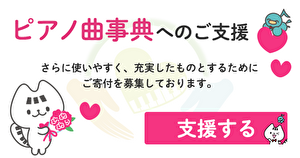作品概要
楽器編成:ピアノ独奏曲
ジャンル:種々の作品
著作権:保護期間中
解説 (2)
解説 : 仲辻 真帆
(556 文字)
更新日:2018年4月19日
[開く]
解説 : 仲辻 真帆 (556 文字)
〈夜の狂想曲〉、〈さくらさくら〉、〈春のやよい〉 で構成されている。この 3 曲は、もともと各曲が独立した作品だった。後年に作曲者の手で組み合わされ、《花に因んだピアノ曲》として発表された。
第 1 曲目の〈夜の狂想曲〉は、神田明神の夜祭に咲き乱れる牡丹の花への回想から作曲された。なめらかな 3 連符がゆったりたゆたう。この曲は、ロシア人のピアニストで作曲家の A. チェレプニンが発行した楽譜叢書「チェレプニン・コレクション」に含まれている。第 2 曲目は、よく知られた日本古謡を単一主題としたソナタ形式である。作曲者によると、第 3 曲目は「都節 6 音階の古謡への扱いが進んでいる」作品である。主題の反行や逆行が盛り込まれている。
箕作秋吉は、1930 年代から「日本和声」にかんする論考を発表していた。《花に因んだピアノ曲》は、箕作の主張が実践的に反映された事例として解することができる。また、作曲者はフランス印象派の影響を受けたことも認めている。西洋音楽をとりいれて日本人としての作曲をきりひらくことに意欲的であった箕作の姿勢が、この作品に表れている。
《花に因んだピアノ曲》は、作曲技法の点において、あるいは 3 曲とも後年に自身の管弦楽曲に用いられたという点において、箕作の作品の重要な位置を占める。
About work(s) : 仲辻 真帆
(1574 文字)
更新日:2018年4月19日
[開く]
About work(s) : 仲辻 真帆 (1574 文字)
This work consists of 3 small pieces such as ‘Night Rhapsody’, ‘Cherry blossom’ and ‘March of spring’. These pieces were at the beginning composed independently, and later Mitsukuri reconstructed them as one suite in later years. It is published as “Three Piano Pieces Associated with Flowers”.
The first piece of the suite ‘Night Rhapsody’ was composed looking back on the flower of Peony which bloomed profusely at the night festival in Kanda Shrine in Tokyo. Legato triplets in the piece sing comfortably. This piece is included in ‘Tcherepnin Collection”, a collection of music scores published by A. Tcherepnin who was a pianist and composer. The second piece of the suite is written in sonata form which has one main subject: a famous Japanese old song. According to the composer, the third piece of the suite was written by ‘Miyako-bushi’ scale ( Japanese traditional scale). The piece includes inversion and retrograde of the theme.
Shūkichi Mitsukuri published some discussions about ‘Japanese harmony’ from 1930s, and “Three Piano Pieces Associated with Flowers” reflects his arguments in practice. As well as his ideas about ‘Japanese harmony’, Mitsukuri was aware that he was affected by French Impressionists. Mitsukuri was eager to accept western music and open up the compositional field as a Japanese.
“Three Piano Pieces Associated with Flowers” has an important position in the Mitsukuri’s works, in terms of both his compositional technique used to this piece and the fact that these three pieces in the suite were each used in his later orchestral works.


